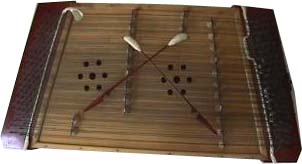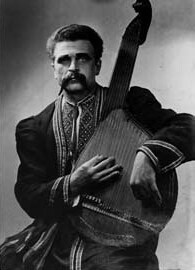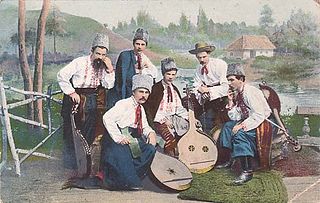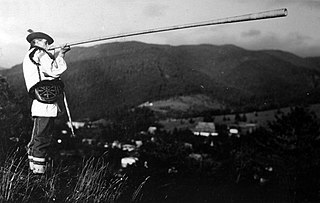
The autoharp is a musical instrument in the chorded zither family. It features a series of chord bars attached to dampers, which, when pressed, mute all of the strings other than those that form the desired chord. Although the word autoharp was originally a trademark of the Oscar Schmidt company, the term has colloquially come to be used for any hand-held, chorded zither, regardless of manufacturer.

The tsymbaly is the Ukrainian version of the hammer dulcimer. It is a chordophone made up of a trapezoidal box with metal strings strung across it. The tsymbaly is played by striking two beaters against the strings.

The cimbalom is a type of chordophone composed of a large, trapezoidal box with metal strings stretched across its top. It is a musical instrument commonly found in the group of Central-Eastern European nations and cultures, namely contemporary Hungary, Slovakia, Czech Republic, Croatia, Romania, Moldova, Ukraine, Belarus and Poland. It is also popular in Greece and in gypsy music. The cimbalom is (typically) played by striking two beaters against the strings. The steel treble strings are arranged in groups of 4 and are tuned in unison. The bass strings which are over-spun with copper, are arranged in groups of 3 and are also tuned in unison. The Hornbostel–Sachs musical instrument classification system registers the cimbalom with the number 314.122-4,5. Moreover, the instrument name “cimbalom” also denotes earlier, smaller versions of the cimbalom, and folk cimbaloms, of different tone groupings, string arrangements, and box types.

The kobza, also called bandurka is a Ukrainian folk music instrument of the lute family, a relative of the Central European mandora. The term kobza however, has also been applied to a number of other Eastern European instruments distinct from the Ukrainian kobza.
The torban is a Ukrainian musical instrument that combines the features of the Baroque Lute with those of the psaltery. The Тorban differs from the more common European Bass lute known as the Theorbo in that it had additional short treble strings strung along the treble side of the soundboard. It appeared ca. 1700, probably influenced by the central European Theorbo and the Angelique which Cossack mercenaries would have encountered in the Thirty Years' War, although the likelier possibility is that certain Tuliglowski, a paulite monk, was its inventor. The Torban was manufactured and used mainly in Ukraine, but also occasionally encountered in neighbouring Poland and Russia. There are about 40 torbans in museums around the world, with the largest group of 14 instruments in St. Petersburg. The term "torban" was often misapplied in the vernacular in western Ukraine to any instrument of the Baroque Lute type until the early 20th century.

A banduryst is a person who plays the Ukrainian plucked string instrument known as the bandura.
The Poltava Bandurist Capella was vocal-instrumental ensemble who accompanied themselves on the multi-stringed Ukrainian bandura. It was initially established in February 1925, based on a male church choir who sang in the Ukrainian Autocephalous Orthodox Cathedral in Poltava under the direction of Fedir (Khvedir) Popadych. The ensemble was disbanded in October 1934.

The Kyiv Bandurist Capella is a male vocal-instrumental ensemble that accompanies its singing with the playing of the multi-stringed Ukrainian folk instrument known as the bandura.
Leonid Haydamaka has left his impression on the development of bandura art in the 20th century.
The Prague Bandurist Capella was a musical ensemble formed in 1924 by Ukrainians living in Czechoslovakia featuring performers on the bandura.
Volodymyr Ivanovych Yurkevych was a Ukrainian musician.
A Kuban bandurists is a person who plays the Ukrainian plucked string instrument known as the bandura, who is from Kuban, a geographic region of southern Russia surrounding the Kuban River.
The Honcharenko Brothers—Alexander (1913–2005) and Peter —became the dominant bandura-makers and designers in the Ukrainian diaspora.
The Leontovych Bandurist Capella was a male choir whose members accompanied themselves using a Ukrainian folk instrument known as a bandura. It was established in the displaced persons camps in Germany in 1946 and had an active performance schedule until 1949.
The dentsivka (Denchivka) is a woodwind musical instrument. The dentsivka is often commonly called a sopilka, however, it differs from the true sopilka in that the dentsivka has a fipple, like the western European recorder. It is thus classified as a duct flute.
Kharkiv-style banduras are banduras that allow for the playing of the Kharkiv style, i.e. using the left hand to play melodic figures primarily over the side of the instrument as opposed to the Kiev style where the left hand primarily plays the basses. To allow for the added required dexterity of the left hand, the instrument is held parallel to the body of the player.

The Hnat Khotkevych Ukrainian Bandurist Ensemble is a vocal and instrumental Ukrainian folkloric performing ensemble in Sydney, Australia. It was founded in June 1964 by bandurist Hryhory Bazhul and since May 1971 was directed by Peter Deriashnyj.










